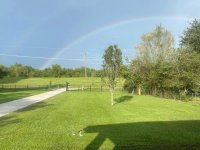Some tips for those of you whose homes might not be built for this sort of cold. Most of these were shared to me by a plumber friend who really does not enjoy making emergency calls when it's -20˚F outside.
Make sure all hoses are disconnected from outside spigots. A hose left connected can hold water in the spigot and the bit of pipe running through the house wall. If it gets cold enough that pipe can burst when the water freezes and expands. (What many don't realize is that even an open hose can hold enough water in the spigot to become a problem.) At least in our northern climates, the actual shut-off mechanism on a good outdoor hose spigot is inside the wall (even though the knob is outside, and the pipe running through the wall is downsloped so that when shut off, the pipe drains out the spigot.
Open the cabinet doors under kitchen and bathroom sinks and any other water-using appliances on the outer walls of the house. You want the heat to circulate to any pipes under there. Unless your house is very well sealed and insulated, it can get substantially colder inside closed cabinets along outside walls. This is especially true on the upwind side of the home and in corners where two outside walls come together or where natural air circulation is poor.
Move couches, beds, pillows, etc. away from heaters. You want the air circulating unrestricted around them.
Keep heat circulating to any colder parts of the home where there are water pipes. If you find a cold spot, find a safe way to get heat to it. You may have to rotate space heaters to different areas of the home to keep things from freezing up.
Don't decide to save money by turning off or turning down your central heat and firing up your wood stove. If you have any way to keep your central heating system going, do so. The problem with turning it down is that your wood stove can keep your heating system from coming on. That may sound great until you realize that your woodstove on one end of the house is fooling the thermostat in the middle into not coming on. Now that baseboard heat on the far end does not have any circulation. Those water filled pipes are just an inch from an outside wall. Gaps in insulation can cause cold spots (especially corners where you may have just studs with little more effective insulation). Keep the water circulating in your heating system to keep a cold spot from freezing up. Once an are turns to slush, it will stop circulating.
Turn on faucets to check water flow. If it doesn't flow, get heat to it safely and soon. Some folks will leave a faucet dripping to help keep it from freezing up (interior faucets only!) If you do this, remember to check that your drain is functioning properly.
Know where your main water shut off is. (and hopefully any secondary shutoffs). If you hear a bang, your pipes have probably frozen. (A metal pipe sounds almost like a gun going off when it bursts. I have no idea what a plastic pipe sounds like.) Minimize damage by shutting things off as quickly as possible, so you don't continuously pour more water into the problem.

